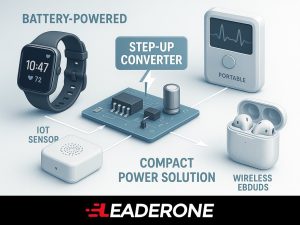
Illustration of electronic devices like wearables and IoT sensors using small boost converters to step up voltage from batteries.
Small boost converters are fundamental components in modern electronics. They efficiently step up a lower input voltage to a higher output voltage. This capability is vital for powering a wide array of devices. Think about battery-powered gadgets, portable medical devices, or even Internet of Things (IoT) sensors. These often need a higher voltage than their power source provides. Understanding their concept and working principle is key to designing compact and efficient power solutions.
The Core Concept of a Boost Converter
A boost converter, also known as a step-up converter, belongs to the family of DC-DC switching converters. Its primary function is to transform a direct current (DC) input voltage into a higher DC output voltage. Unlike linear regulators, which dissipate excess voltage as heat, boost converters achieve efficiency by rapidly switching an energy-storing inductor. This makes them ideal for extending battery life and enabling devices to operate from lower voltage sources.
How a Small Boost Converter Works: The Principle of Operation
The operation of a small boost converter relies on a few key components: an inductor, a switching element (typically a MOSFET), a diode, and an output capacitor. Here’s a simplified breakdown of its two main phases:
Phase 1: Storing Energy in the Inductor (Switch ON)
- Switch Closes: The control circuit turns the MOSFET switch ON.
- Inductor Charges: Current flows from the input voltage source through the inductor to the switch and then to ground. During this time, the inductor opposes the change in current by storing energy in its magnetic field.
- Diode Blocks: The diode is reverse-biased, preventing current from flowing to the output capacitor. The output capacitor supplies current to the load during this phase, maintaining the output voltage.
Phase 2: Releasing Energy to the Load (Switch OFF)
- Switch Opens: The control circuit turns the MOSFET switch OFF.
- Voltage Inducement: The inductor resists the sudden change in current flow. It generates a large voltage spike (back EMF) across itself. This voltage adds to the input voltage.
- Diode Conducts: The combined input voltage and the inductor’s induced voltage are now higher than the output voltage. This forward-biases the diode.
- Capacitor Charges & Load Powers: Current flows through the diode, charging the output capacitor and simultaneously supplying power to the load. The capacitor smooths out the pulsating current from the inductor, providing a stable DC output voltage.
This cycle repeats at a very high frequency, often in the kilohertz or megahertz range. The output voltage is regulated by controlling the duty cycle of the switch (the ratio of ON time to the total switching period). A longer ON time stores more energy in the inductor, resulting in a higher output voltage.
Key Considerations for Small Boost Converters
When designing or selecting small boost converters, several factors are crucial:
- Efficiency: High efficiency means less energy wasted as heat, crucial for battery-powered applications.
- Output Current Capability: The maximum current the converter can deliver to the load.
- Input Voltage Range: The range of input voltages the converter can accept.
- Output Voltage Ripple: The small AC variation present on the DC output voltage, which should be minimized.
- Quiescent Current: The small amount of current the converter consumes when the load is very light or absent. Lower quiescent current extends battery life in standby modes.
- Footprint: For small electronics, the physical size of the converter and its external components is critical.
The Future of Compact Power Solutions
Small boost converters are indispensable for today’s compact electronics. As devices shrink and demand for longer battery life grows, these converters will continue to evolve. Innovations in integrated circuits are leading to smaller, more efficient, and more feature-rich boost converters. They will remain a cornerstone of power management, enabling the next wave of portable and IoT technologies.
